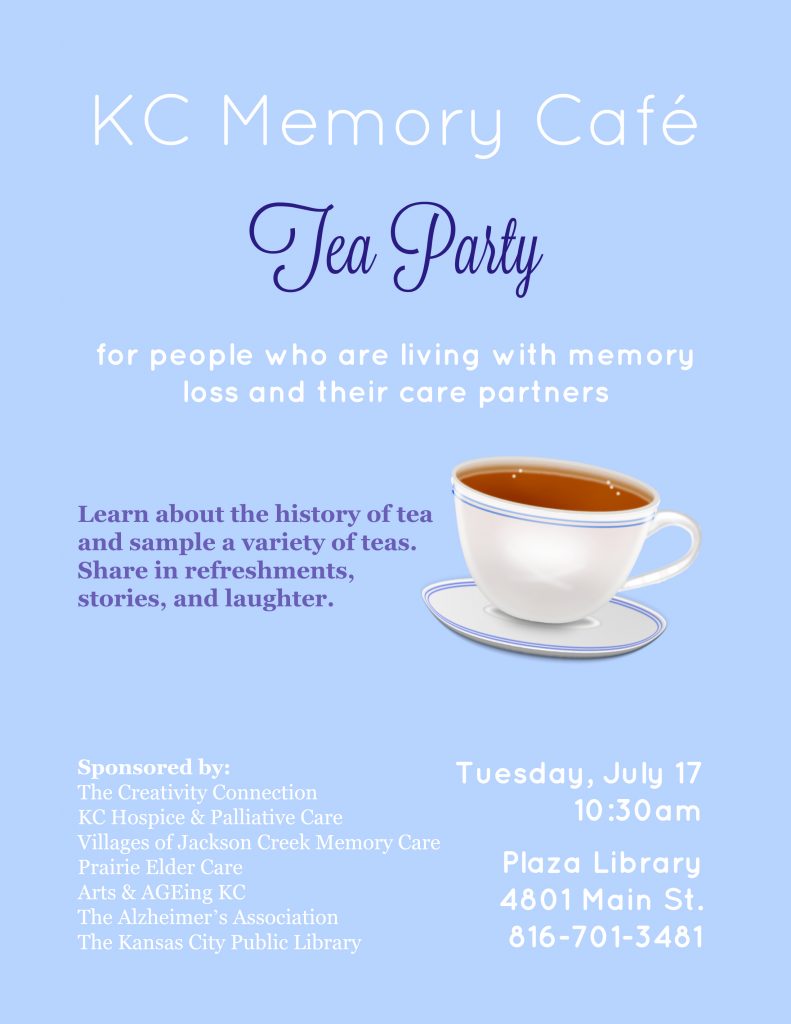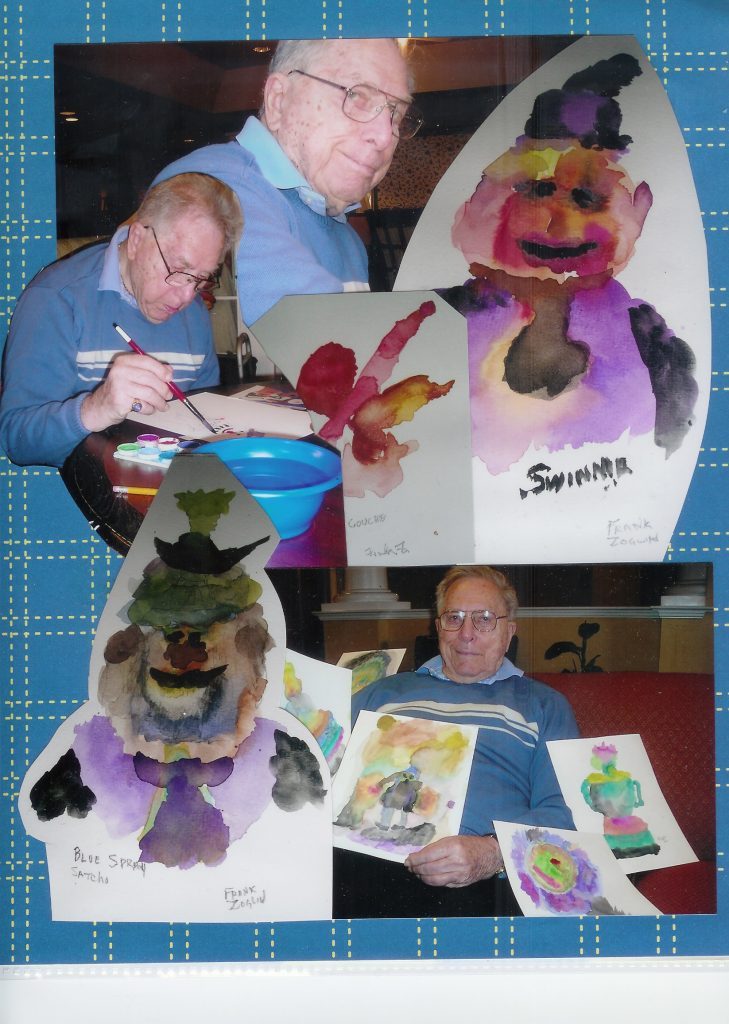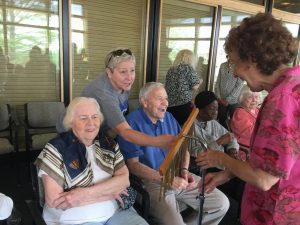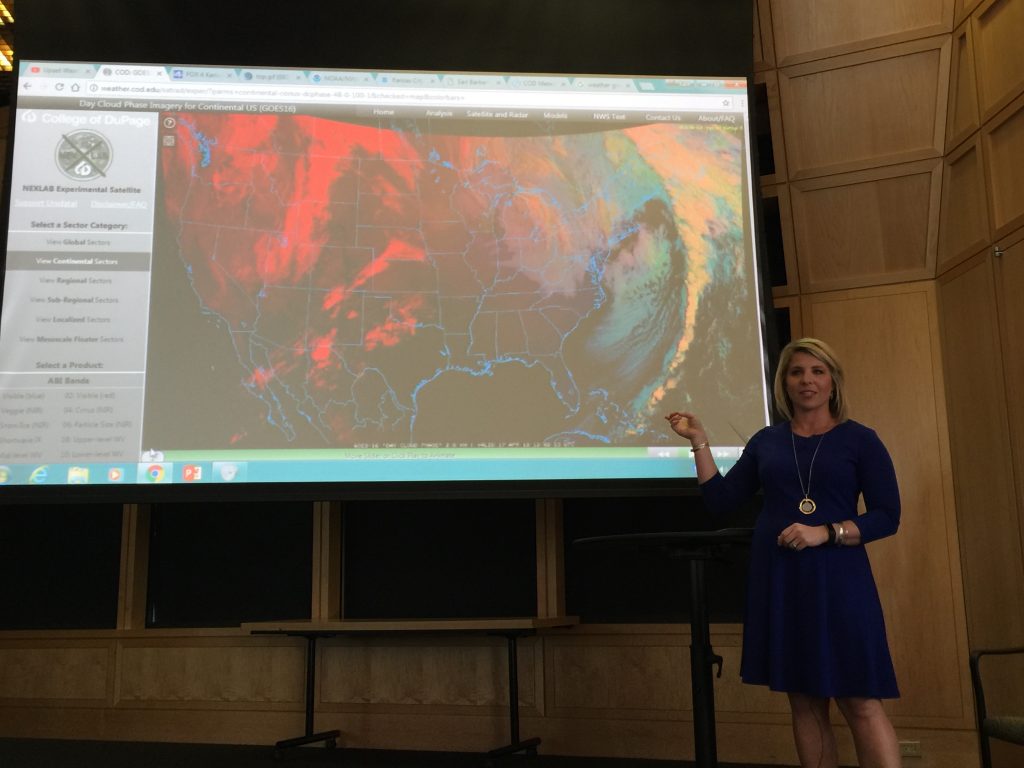Posts Tagged ‘care partners’
A Stirring Tea Party Brings People Together
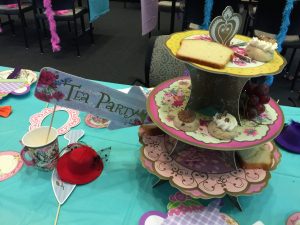 It took us an hour to prepare for our festive tea party and we all enjoyed every moment of it. Jennifer Walker, RN, BSN, Clinical Community Liaison, Kansas City Hospice & Palliative Care, knows how to throw a party. She brought pastel table cloths, a charming complement of paisley-printed cups and plates, along with tiered cookie holders.
It took us an hour to prepare for our festive tea party and we all enjoyed every moment of it. Jennifer Walker, RN, BSN, Clinical Community Liaison, Kansas City Hospice & Palliative Care, knows how to throw a party. She brought pastel table cloths, a charming complement of paisley-printed cups and plates, along with tiered cookie holders.
For the ladies, she offered colorful fascinators (small hats you can clip into your hair) and bright boas. For the men, she had bow ties and top hats. She also brought the ingredients for tea time sandwiches and a variety of cheeses, veggies and meats. Kathi Michaels and Heidi Underwood from Leawood Gardens, and Lainey Berry, from the Law Office of Love & Blomquist, generously provided an array of baked treats, including legendary cookies from McClain’s Bakery and delectable lemon squares.
Our guest speaker, Emilie Jackson from Emilie’s French Teas, shared information about the international history, social rituals, and health benefits that come with sipping a cup of tea. After her talk, everyone set to work creating cucumber and cream cheese sandwiches, with the crusts cut off, of course. We were able to smell several different teas and each person chose a favorite to savor. The food and drink were delicious but even better were the conversations. Each table got into discussions about tea, coffee, life, and more. One guest enjoyed a tete a tete in French with Emilie, who is originally from France. 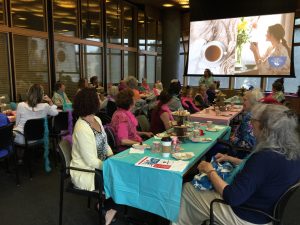
The gathering was so much fun and so engaging, with all the aromas, tastes, and textures, that none of us wanted to leave. It took us even longer to clean up after the stirring tea party, because we had to help eat the leftovers!
Click on this link for the inside story on our tea party: Memory Cafe, Tea Party
Here are a few of our favorite tea quotes:
Where there’s tea there’s hope. Arthur Wing Pinero
If you are cold, tea will warm you; if you are too heated, it will cool you; If you are depressed, it will cheer you; If you are excited, it will calm you. William Ewart Gladstone
I like the pause that tea allows. Waris Ahluwalia
A woman is like a tea bag – you can’t tell how strong she is until you put her in hot water. Eleanor Roosevelt
Please join us for our next cafe when the great Nick Haines brings us the inside story on KC local news. We can’t wait!
Our team, ready for tea
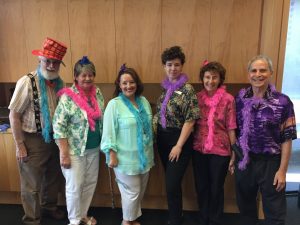

Thanks to our sponsors:
The Kanas City Public Library
The Alzheimer’s Association
The Creativity Connection, Deborah Shouse and Ron Zoglin
Kansas City Hospice and Palliative Care
Arts & Aging KC
KC FilmFest
Prairie Elder Care
The Villages of Jackson Creek Memory Care
Dennis and Carol McCurdy, Community Volunteers
Please email Deborah at myinfo@pobox.com if you need additional information.
And, we hope you can join us for our next events.
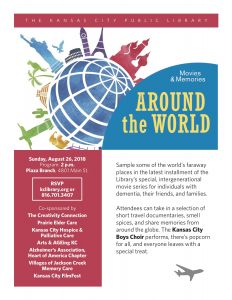


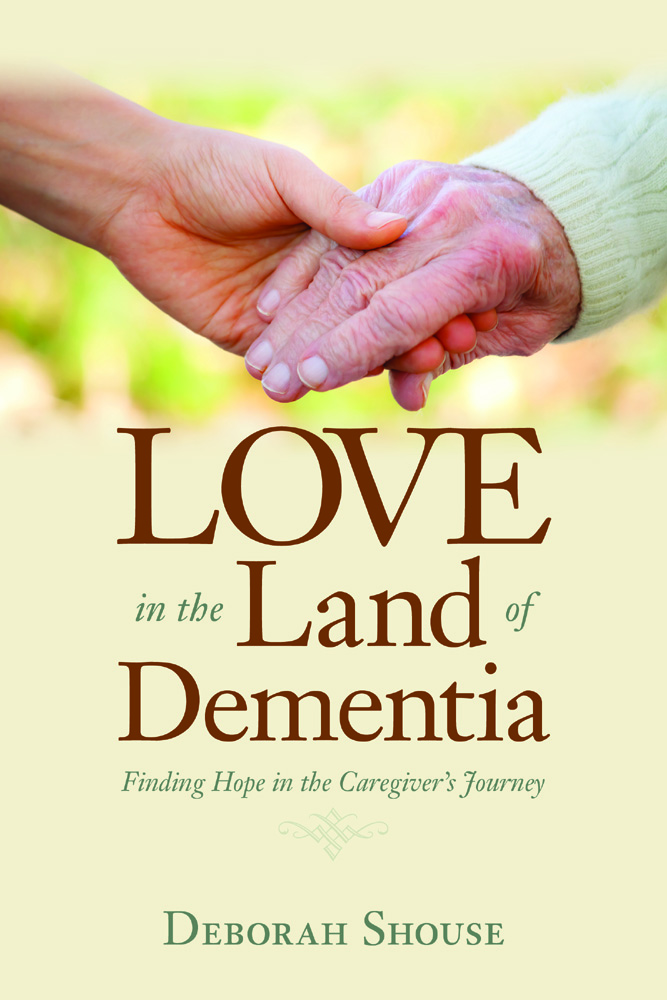
One-Minute Tips to Boost Your Happiness
I am thrilled to be a contributor to Chicken Soup’s new book, The Empowered Woman. I’m going to be featured 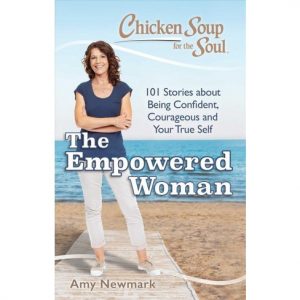 on publisher Amy Newmark’s podcast on May 25, where I talk to her about my “empowered” story and about the dementia journey. Click here to listen to the podcast. Amy is very inspiring and I wanted to share some of her One-Minute Tips to Boost Your Happiness,
on publisher Amy Newmark’s podcast on May 25, where I talk to her about my “empowered” story and about the dementia journey. Click here to listen to the podcast. Amy is very inspiring and I wanted to share some of her One-Minute Tips to Boost Your Happiness,
Speaking of empowered women, Amy Newmark left her high-powered career as a Wall Street analyst to take over the Chicken Soup series. After years of immersing herself in true stories of miracles, lessons learned, and hopes fulfilled, she wrote her own book,Simply Happy. Here are some of her “One-Minute Tips to Boost Your Happiness.”
Amy’s Insights for Care Partners
 Counting Blessings Adds Up to Happiness
Counting Blessings Adds Up to Happiness
“The gateway to happiness is counting your blessings,” Amy says. “If you’re not grateful for what is in your life, how can you be happy?”
Scientific studies have proven that people who are actively grateful are happier, healthier, and more productive. Plus, they get along better with family members, colleagues, and others.
“You can easily learn gratitude,” Amy says.
To start, each day jot down three things for which you’re grateful. Strive for three different ideas each day. At the end of the month, you’ll have documented nearly a hundred blessings.
“Writing and speaking your gratefulness changes your perception,” Amy says. “You start looking for good things during the day. You can share your blessings with your partner and encourage him to consider his own.”
Some people drop the blessings into a box, and then read them at the end of the day or the end of the month.
Smiling Serves You
Smile even when you don’t feel like it. Often, when you smile, people smile back. This boosts everyone’s spirits and energy. If they don’t give you a grin, it doesn’t hurt you.
“Your smile will change the way people react to you,” Amy says.
Zipping from Zero to 60 Brings Joy
Set a timer for 60 seconds and zip through a task you’ve been putting off. File the insurance policy that sprawls across the dining room table. Unload the dishwasher. Take your vitamins.
“Doing even one of those tasks every day will lighten your spirits,” Amy says.
Dropping Perfection and Embracing Your Own Abilities
Abandon your pursuit of perfection and strive for your own version of excellence.
“When you try to be perfect, you can’t get a lot done,” Amy says. “For most of us, it’s better to do five things at 90 percent than one thing at 100 percent.”
I love Amy’s final piece of wisdom:
“Treat yourself nicely,” she says. “Use the fragrant soap you save for guests. Indulge in a rich bit of good chocolate or a fresh crisp apple. Put the good sheets you save for company on your own bed.
Give yourself a tiny pleasure every day.”
For more happiness boosts, read Simply Happy.


Connected in the Land of Dementia: Easy Ideas and Free Events
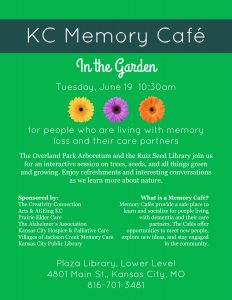
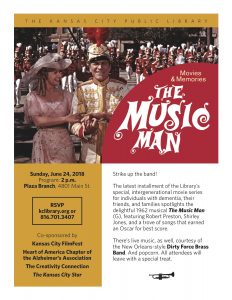


Father’s Day Tips: Four Fabulous Ways to Celebrate When Dad has Dementia
“Dad always liked a big Father’s Day celebration,” my friend told me. “But now he’s deep into dementia; I’m not sure he would notice.” When Ron’s dad Frank relaxed into dementia, Ron and I often struggled with how to approach Father’s Day. Even though Frank didn’t know what day it was, we still wanted to honor Frank as a father. Here are four fabulous ways to celebrate when Dad has dementia.
Reminiscing over Favorite Foods
We brought in a meal created from some of Franks’ current favorites and some gems from the past. Frank’s wife Mollie made her world-famous brownies and legendary rice pilaf. We bought cooked steaks and baked potatoes and as we ate, we talked about meals past. Inspired by the familiar tastes, smells and textures, Frank recited one of this favored old phrases: “I’m cool to other women but I’m hot tamale (Hot to Mollie.)”
Naming His Tunes
Frank and Mollie liked to dance occasionally and for one celebration, we printed out song lyrics and sang Frank and Mollie some of their old favorites. We didn’t sound like Sinatra or Fitzgerald as we warbled “It Had to be You,” or “Stardust” or “Three Coins in the Fountain” but we did sound sincere!
Life Stories
Ron and I created a HERO Project for Frank, a story-scrap book that incorporated highlights and photos from Frank’s life, along with a meaningful storyline. We also created one for Mollie. We read the HERO Projects with Frank and Mollie, using the stories as conversational catalysts. Frank enjoyed the experience; we enjoyed reading aloud with Frank and remembering shared experiences.
Celebrating Special Qualities and Life Lessons
As we sat together, we talked about some of Frank’s many stellar qualities, which included his easy-going nature, his natural charm, his entrepreneurial spirit, and his willingness to try new things. “Did I really do that?” Frank asked, as Ron described the bowling alley Frank and his brother owned and operated. “You did,” Ron said.“That was really something,” Frank said.
Frank’s comment summed up our Father’s Day celebration: it was really something. Just being together was wonderful. And taking time to really celebrate Frank with a tender mixture of food, photos, stories, and conversation was pure magic.
For more ideas on Naming His Tunes, please visit the exciting MusicandMemory.org


Creating Low-Cost, Engaging Activities
Creating Low-Cost, Engaging Activities
 Alice looks blankly at the magazine as Kimberly Clark turns the pages, pointing to various pictures. “What do you think of this? Or this?” she asks, pointing to a rose, a table set for tea, a bundt cake. When Kimberly touches a picture of a train, Alice smiles. Although Alice, who is living with dementia, can no longer tell her own stories, Kimberly has heard tales of her adventurous past. When Alice was a restless young woman, she and her new husband occasionally jumped on a freight train and took a ride. This photo will be the centerpiece of the collage they are making. As Program Coordinator at ARC Jackson County, a lifespan respite program in Medford, Oregon, Kimberly is an expert at creating low-cost, engaging activities for people who are living with dementia.
Alice looks blankly at the magazine as Kimberly Clark turns the pages, pointing to various pictures. “What do you think of this? Or this?” she asks, pointing to a rose, a table set for tea, a bundt cake. When Kimberly touches a picture of a train, Alice smiles. Although Alice, who is living with dementia, can no longer tell her own stories, Kimberly has heard tales of her adventurous past. When Alice was a restless young woman, she and her new husband occasionally jumped on a freight train and took a ride. This photo will be the centerpiece of the collage they are making. As Program Coordinator at ARC Jackson County, a lifespan respite program in Medford, Oregon, Kimberly is an expert at creating low-cost, engaging activities for people who are living with dementia.
Creating collages is easy, inexpensive, and relaxing. Medical offices will donate their old magazines and she also collects periodicals from friends. If Kimberly knows her client’s family stories, she seeks magazines that have illustrations relevant to them. She lays out a variety of magazines and asks, “Which one do you want to look at first?” They sit together and Kimberly slowly turns pages, listening for comments, watching body language, and facial expressions. When she sees interest or excitement, she may ask, “What are you looking at?” or “What does this remind you of?” She then tears out the picture and sets it aside, so it’s not distracting. Once they have a nice group of photos, they start on the collage, cutting and pasting together.
“The project is empowering and can spark discussion,” Kimberly says. “Plus, we can take our time and we have something artistic and interesting to discuss when it’s done.”
She often uses the finished collage again and again as a conversation starter.
Kimberly also engages people through simple nature walks, where they notice the colors, shapes, wildlife, and collect vibrantly colored leaves, pinecones, acorns, and more.
She celebrates people’s individuality by writing their name on watercolor paper in black marker and inviting them to fill in the letters and surroundings with colored pencils.
When people need a little exercise and a good laugh, she invites her dog to join them in a sparkling game of balloon volleyball. Her dog is an expert at keeping the balloon aloft and soon everyone is supporting him in this uplifting endeavor.
“Even if you’re not in a good mood, doing some kind of art, exercise, or creative project makes you stop and appreciate the present,” Kimberly says.


KC Memory Cafe Creates The Sounds of Music: A Visit from the Kansas City Symphony
 If there’s anything more fun than a one-man band, it’s a one-woman orchestra. On May 15, Margaret Halloin graced the cafe with an astonishing array of instruments. She invoked our inner Itzhak when she introduced us to the versatility of the violin. One moment she used a series of chords to transport us to a hoedown; then she built the tension by creating the sounds of of a chase scene. We were mellow with the cello and sliding cool with the trombone. We could all feel the beat as she tapped and shook a variety of percussion instruments. And then, she invited all of us to play
If there’s anything more fun than a one-man band, it’s a one-woman orchestra. On May 15, Margaret Halloin graced the cafe with an astonishing array of instruments. She invoked our inner Itzhak when she introduced us to the versatility of the violin. One moment she used a series of chords to transport us to a hoedown; then she built the tension by creating the sounds of of a chase scene. We were mellow with the cello and sliding cool with the trombone. We could all feel the beat as she tapped and shook a variety of percussion instruments. And then, she invited all of us to play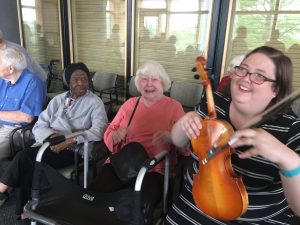 Instantly the room transformed from a quietly listening group of adults to a boisterous band of emerging musicians. One couple beat on a drum together. A woman tentatively held the violin. When Margaret helped her coax a sound of out it, she burst into delighted laughter. People tried the cello, the gong, the bongos, and the French horn. Even better than the sounds of music were the spurts of laughter and the lively conversations. After our chaotic impromptu concert, we gathered in small groups to talk about the music in our lives. One man had been a professional pianist. Several people had played in marching bands. Some had never touched an instrument. Until today.
Instantly the room transformed from a quietly listening group of adults to a boisterous band of emerging musicians. One couple beat on a drum together. A woman tentatively held the violin. When Margaret helped her coax a sound of out it, she burst into delighted laughter. People tried the cello, the gong, the bongos, and the French horn. Even better than the sounds of music were the spurts of laughter and the lively conversations. After our chaotic impromptu concert, we gathered in small groups to talk about the music in our lives. One man had been a professional pianist. Several people had played in marching bands. Some had never touched an instrument. Until today. 
- Invite several musical kids/friends/relatives to come over, tell you about their instrument, and help you make a sound on it.
- Have fun playing imaginary instruments along with a big band or big orchestra music.
- Listen to favorite instrumentals and talk about any memories evoked.
- Look at pictures of various instruments and share stories. Ask open-ended questions with no right or wrong answers, such as, “ What do you think about the piano?” “What are some of your favorite instruments?”
Please join us for our next events:




Celebrating our Mothers
If my mother were still alive, I would be taking her roses and chocolate this Mother’s Day. She would be delighted and her delight would magnify when my daughters and her great-grandchildren arrived. Love is such a beautiful glue, such a simple and strong way to stay connected. I wanted to share this story from Love in the Land of Dementia, as a way of celebrating our mothers.
The Woman She Was
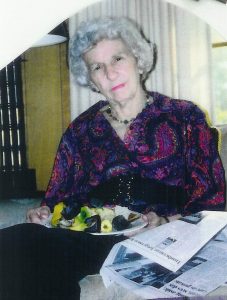 My friend Karen gives me a gift: she says, “Tell me about your mother.”
My friend Karen gives me a gift: she says, “Tell me about your mother.”
We are sitting in a quiet mid-afternoon café and I let the question sink into me.
When friends occasionally ask me, “How is your mother doing?” I have different answers, depending on the situation. If we are in one of those conversations that are like confetti in brisk wind, I say, “She’s okay.”
If we are sitting across from each other and my friend is looking right at me, I answer, “She’s pretty deep into Alzheimer’s.”
“Does she recognize you?” she might ask.
“No, but she may recognize I am a person she likes,” I answer.
That usually ends that conversation.
But “Tell me about your mother,” is an invitation I don’t usually get.
“What would you like to know?” I ask.
She stirs her iced mocha. “Whatever you want to tell me,” she says softly. “I would like to know about her life and her interests.”
Since my mother has been in the nursing home with Alzheimer’s, I have seldom talked about the person she used to be. Occasionally my father and I reminisce about family vacations and outings. I sometimes ask Dad questions about our growing up days and the early days of their courtship. But I rarely think about the woman I knew all my life, the mother, grandmother, artist, gardener, compassionate friend, avid reader, bird-watcher, early morning walker, lemon-meringue pie baker. That woman is gone and I have spent a lot of energy learning to know and appreciate the woman who now commandeers her body.
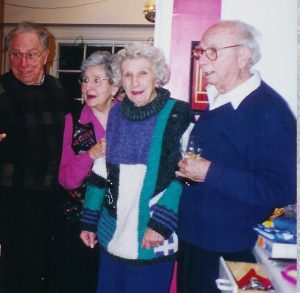 As I consider what I want to tell Karen, I remember visiting my mom’s best friend, Bel, in California when I was a teenager. Bel, who was spunky and adventurous in a way that seemed so different from my conservative mother, drove me from Berkeley to the small resort where I would work as a chambermaid for the summer.
As I consider what I want to tell Karen, I remember visiting my mom’s best friend, Bel, in California when I was a teenager. Bel, who was spunky and adventurous in a way that seemed so different from my conservative mother, drove me from Berkeley to the small resort where I would work as a chambermaid for the summer.
“Do you know how I met your mom?” she asked me, as we drove down the winding roads, past fragrant stands of eucalyptus trees.
“In Iceland, during the World War II,” I said. I had heard stories of the two of them taking a break from their work in the hospital by skiing, then stopping for a soak in a hot springs.
“No, we met earlier in Chicago. We were both nurses working the twelve-hour night shift. The hospital had a room with a couple of bunk beds so we could rest on breaks. One night I walked in there and heard the most heart-breaking sobbing. It was Frances, crying her eyes out. I asked her what was wrong and she said, ‘Nothing.’”
I smiled. That sounded like Mom, never wanting to admit anything was wrong.
“Then I asked her again and she sobbed out that her husband Sam had died six months ago from pneumonia. She was so sad she didn’t know if she could go on. A bunch of other nurses and I were going to Florida for a short vacation and I persuaded your mother to join us. But as it turned out, we never went; a week later I decided to join the Army and I encouraged her to come along. We’ve been best friends ever since.”
When I heard this story at the age of seventeen, I was too young to fathom my mother’s grief and despair. By the time I told Karen the story, I had some sense of what my mother must have gone through.
“Your Mom was really brave, to serve in the Army during wartime,” Karen says.
I feel a little swell of pride. Mom’s tales of traveling in the darkest night on the troop ship, with bombs falling nearby, were so familiar I had never considered her bravery and courage.
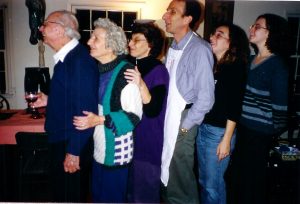 Now I tell Karen how my father, encouraged by Bel’s husband, wrote Mom a letter, telling her he was ready to marry a nice Jewish girl. Was she interested? Was she available?
Now I tell Karen how my father, encouraged by Bel’s husband, wrote Mom a letter, telling her he was ready to marry a nice Jewish girl. Was she interested? Was she available?
After some correspondence, Mom surprised herself by agreeing to meet him in Chicago. At the end of the week, my father asked her to marry him. She considered the offer for three weeks and accepted. Their whirlwind romance was fueled by practicality.
“What a great story,” Karen says. “Your mother must be an amazing woman.”
Sparked by Karen’s interest, I let myself feel my love for my mother as she used to be. I am in tears by the time our conversation ends.
“Thank you for asking me about my mother,” I say to Karen.
“Your stories make me want to call my own mom and hear her stories again.”
As I drive home, I think of more “mom” stories to share with my children and my brother. I see myself, along with my brother and father, as the carrier of my mother’s sacred legacy. I imagine myself tenderly fanning the embers, adding dry leaves and crumbled paper, creating a blaze with each memory. I realize I don’t have to give up Mom’s old self: I can be her historian and her scribe, carrying her stories with me, and making sure they live on.


KC Memory Cafe: Great Weather Information Inspires Great Conversations
 Karli Ritter is a self-described “weather nerd.” When this Fox 4 meteorologist finished her lively talk at April’s KC Memory Cafe, we all had a bit of that “weather nerd” fever in us. We listened intently as Karli described her early morning routine, up at 4:30 a.m., studying the weather maps and data so she could formulate a forecast. She detailed the complexities of being an integral part of a five-hour show: she actually appears on TV 90 times during the Kansas City Fox morning show! Her talk reminded us that great weather information inspires great conversations.
Karli Ritter is a self-described “weather nerd.” When this Fox 4 meteorologist finished her lively talk at April’s KC Memory Cafe, we all had a bit of that “weather nerd” fever in us. We listened intently as Karli described her early morning routine, up at 4:30 a.m., studying the weather maps and data so she could formulate a forecast. She detailed the complexities of being an integral part of a five-hour show: she actually appears on TV 90 times during the Kansas City Fox morning show! Her talk reminded us that great weather information inspires great conversations.
Karli has a love for storms and we were delighted with our “tornado” 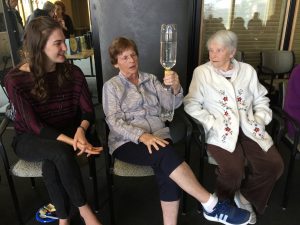 experience, courtesy of the Kansas City Public Library staff. We used a special coupler to link one empty liter bottle with one half full with water. Then we shook and turned it upside down and voila! a little tunnel tornado formed in the water! Each person was fascinated by this experiment. That led us to a conversation about personal weather experiences. Our attendees had gone through hurricanes, earthquakes, dust storms, tornadoes, nor’easter’s and much more.
experience, courtesy of the Kansas City Public Library staff. We used a special coupler to link one empty liter bottle with one half full with water. Then we shook and turned it upside down and voila! a little tunnel tornado formed in the water! Each person was fascinated by this experiment. That led us to a conversation about personal weather experiences. Our attendees had gone through hurricanes, earthquakes, dust storms, tornadoes, nor’easter’s and much more.
Our discussion continued on the way out, with guests describing the varied weather in the Kansas Flint Hills, rainbows they’d seen, family members who loved forecasting the weather, and long hot summers and long cold winters.
To watch our weather wonders, click here.
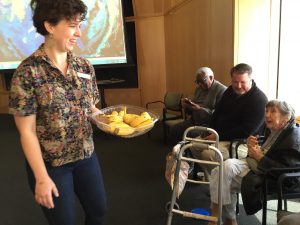
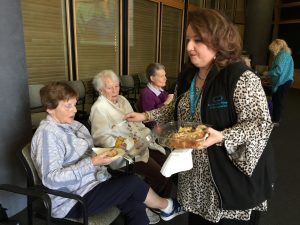 Bringing the weather home.
Bringing the weather home.
To start a weather conversation in your own family or community, use music as a catalyst. Play songs such as: You Are My Sunshine, Stormy Weather, Somewhere Over the Rainbow, Raindrops Keep Falling on My Head, The Sunny Side of the Street, Let It Snow. After each song, ask an open-ended question. “What do you like about snow?” Or,” What seasons do you like most?” Or “Have you ever been in a really big storm?” Or,”What is your favorite kind of weather?”
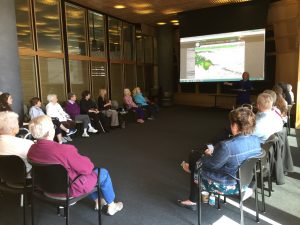
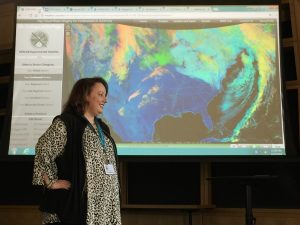 You can also play iconic movie clips that feature weather, such as the joyous tap dancing scene in Singing in the Rain, or the tornado scene in The Wizard of Oz.
You can also play iconic movie clips that feature weather, such as the joyous tap dancing scene in Singing in the Rain, or the tornado scene in The Wizard of Oz.
Dramatic weather photos and pictures can also trigger memories and comments.
Thanks to our Cafe Team and thanks for those who visited.
Our next adventure: May 15, 10:30 to 12:00, Plaza Library
Music to Our Ears: The Kansas City Symphony Brings Us Note-worthy Instruments
You’ve heard them as part of the orchestra. Now you’ll be meeting selected instruments first-hand, as the Symphony’s Margaret Halloin joins us for this delightful interactive session. Enjoy refreshments and interesting conversations as we learn more about the sounds of music.



A Winning Combination: Children, Exercise, and Music
An orderly group of five-year-olds walk into the dining room at Vernon Manor in Viroqua, Wisconsin. The residents are waiting for them. Each child goes up to an elder and introduces him or her self. Then Ingrid Constalie, AD-BC, CDP, Board Certified Activity Director and Certified Dementia Practitioner, talks to the assemblage about the importance of staying fit. The residents nod sagely: many of them are in their eighties and nineties and they exercise every day. But the days that the kindergartners join them are the best, a winning combination or children, exercise, and music.
The residents love teaching the kids the alphabetic movements to the iconic YMCA song. And the kids are a burst of giggles and wiggles as they fold their arms into wings, strut around, and teach everyone The Chicken Dance.
Ingrid’s focus is creating moments of joy, engagement, and connection.
Her intergenerational activities spark the residents and reduce the stigmas of aging and dementia by educating and informing local children, teens, their teachers, and other members of the community.
“This dancing and exercise exchange is simple, energizing, and very successful,” Ingrid says.
Sing-O at Bingo
Music Bingo offers middle schoolers a chance to work with Ingrid’s elders.
“This is about creating a good experience for your partners,” Ingrid coaches the children in advance. “You are their connection to the world.”
Ingrid plays an opening melody, using songs such as “Happy Trails,” “You Are My Sunshine,” and “Singing In the Rain.” Those who know the title shout it out. Often, partners confer with each other. The children help locate the song title on the bingo card and place a poker chip on each answer. Even people living with advanced dementia enjoy listening to music and being around the children.
Most of the time, the school children are chatty and at ease. But one girl was scared coming into the care community.
“I paired her with Helen, a woman deep into dementia,” Ingrid says. “Within minute, Helen had her arm around the girl and they were both laughing.”
Even children who act up at school are wonderfully behaved during the Bingo experience.
Creating Comparisons and Compassion
Recently, Ingrid orchestrated a project with a high school English class. They interviewed residents and did a comparison and a contrast. For example: “While Clara is getting out of bed with the assistance of staff, I am getting ready for school. While she wheels herself down a long hallway to a dining room, I am eating toast with my sister.”
The teenage journalists asked simple questions, like “What is your morning like?” “How do you spend your afternoon?” “How do you like to dress?”
The students wrote up the results and made booklets. One family was so inspired by the insights in the booklet, they later read parts of it at the woman’s funeral.
Ingrid’s intergenerational connections explore understanding, create empathy, and help create exciting new relationships.


My Mom’s New Holiday Tradition: Smiling
**
We roll into the memory care facility’s dining room just as the show is ready to start. The singer, Thelda, kicks off her shoes and presses play on the boom box. Above the cheerful sound track, she sings Jingle Bells. She dances across the room with the remnants of ballroom steps. She stops in front of Mom and sings right to her. She gets on her knees, so she can look into Mom’s eyes, and keeps singing. Mom notices her and smiles a little.
Thelda moves on, singing to each of the patients gathered around, so intent on making a connection that she often forgets the words.
“Is it all right for your Mom to come to Christmas holiday events?” the activity director had asked me, when Mom moved in.
“Yes, I’d like her to go to any activities. She likes the extra energy.”
I think Mom would approve of my decision, even though she has never celebrated Christmas. Growing up, her immigrant mother held on to the Jewish spirit of her home, kneading dough for Friday evening challah, observing each holiday and prayer period in her own way. Some orthodox women followed the religious law that commanded a small piece of the dough be burned as an offering to God. My grandmother was poor; she did not believe in burning good food, regardless of tradition. So she sacrificed a portion of the dough to her youngest daughter, my mother Fran. She created a “bread tail,” leftover dough that she baked, then smeared with butter and sprinkled with sugar . When Mom used to talk about her mother, she always mentioned this special treat.
Even when I was growing up, and we were the only Jewish family in our neighborhood, my mother still did not sing Christmas song. She let the holiday rush by her, like a large train, whooshing past and leaving her behind.
 Now, I am singing Christmas carols to my Mom for the first time and she is smiling. She has moved beyond the place where the religions are different, beyond the place where she wants to separate the dough and make a sacrifice for tradition. Her new tradition is anyone who can make her smile.
Now, I am singing Christmas carols to my Mom for the first time and she is smiling. She has moved beyond the place where the religions are different, beyond the place where she wants to separate the dough and make a sacrifice for tradition. Her new tradition is anyone who can make her smile.
With each song, from White Christmas, to Silver Bells, to Frosty the Snowman, Thelda moves back to Mom, tapping her, acting sillier and sillier. Each time, Mom lifts her head and widens her mouth for a second.
For her finale, Thelda puts on a big red nose and sings Rudolph. When she dances in front of Mom with that scarlet nose, Mom laughs, her face a miracle in pure enjoyment. I laugh too, so delighted to see Mom engaged and absorbed.
Two weeks from now, I will bring a menorah and candles into my mother’s room. My father and I will have a short Chanukah ceremony with Mom. She will pick at the shiny paper covering the Chanukah gelt (chocolate candy disguised as money). She will slump over in her chair. But she will come back to life when she sees me, her only daughter, wearing a big red nose as I light the menorah.Here’s to a meaningful and fun holiday season.
I look forward to connecting with you when I resume blogging in early January.


